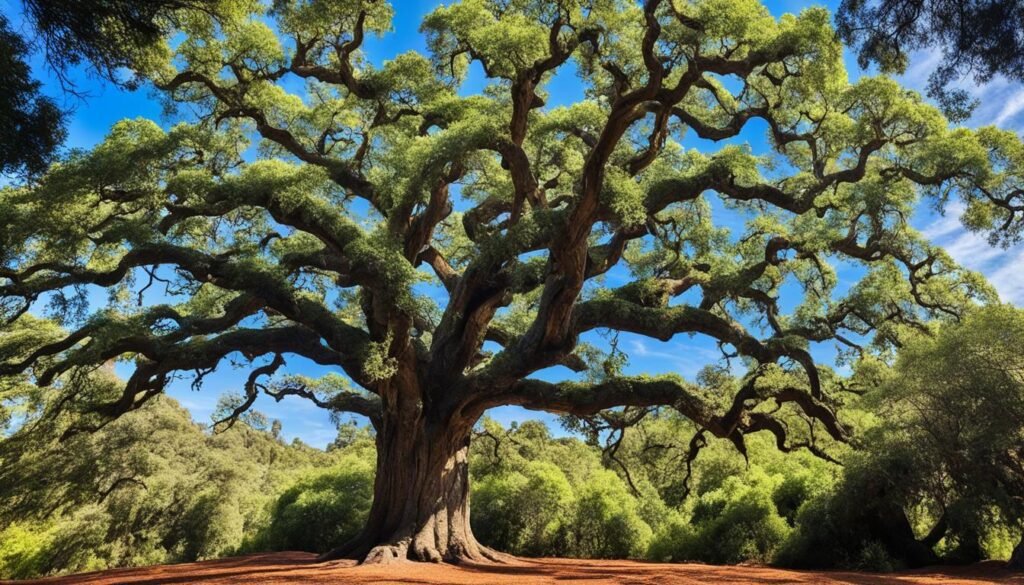Native oaks are a vital and important component of the vegetation in California. They contribute to the landscape’s distinctive character and provide food and shelter for wildlife. Additionally, they help stabilize soil and play a crucial role in the environment by absorbing carbon dioxide and producing oxygen. However, there have been concerns about inadequate natural regeneration in certain areas, highlighting the need for proactive measures to ensure the long-term survival of these species.
This comprehensive guide aims to equip you with successful techniques for growing and caring for oak trees in California. From choosing between acorns and seedlings to maintaining local seed sources and implementing proper planting techniques, this guide has you covered.
Key Takeaways
- Native oaks are an integral part of California’s vegetation and contribute to the overall environment.
- Efforts are being made to address concerns about poor natural regeneration by planting acorns and seedlings.
- Choosing the right planting method, maintaining local seed sources, and implementing proper planting techniques are essential for successful oak tree growth.
- Regular care and maintenance, including proper watering, mulching, pruning, and disease monitoring, are crucial for the health and growth of oak trees.
- Identifying different oak tree species in California can help with selecting the right species for planting and care considerations.
Oak Tree Planting Tips in California
Planting oak trees in California can be a rewarding endeavor that contributes to the natural beauty of the state. Whether you choose to start with acorns or seedlings, there are essential tips to keep in mind for successful growth and establishment.
Choosing Between Acorns and Seedlings
When deciding between acorns and seedlings, several factors come into play. Acorns are easier to plant and can be obtained by collecting them from mature oak trees. However, acorns may face challenges such as being eaten by rodents or not germinating successfully. Seedlings, on the other hand, are more likely to survive if planted correctly at the right time of year. Consider the availability of acorns or seedlings, the planting site conditions, and the potential presence of acorn-eating rodents in your area.
Maintaining Local Seed Sources
It is crucial to maintain local seed sources when planting oak trees in California. Native oaks are adapted to the local climate and conditions, making them more likely to thrive in their natural habitat. By planting oak species that naturally occur in your specific region, you are actively contributing to the preservation of local ecosystems and biodiversity.
Proper Acorn and Seedling Planting Techniques
Collecting and storing acorns properly is essential for successful planting. Harvest acorns from healthy trees, store them in a refrigerator to mimic the natural winter conditions, and soak them in water overnight before planting. For optimal results, plant acorns from early November to early March, burying them half an inch to one inch below the soil surface.
When transplanting seedlings, ensure you handle them with care to prevent transplant shock and root injury. Dig a hole that is wide and deep enough to accommodate the roots without bending or crowding them. Gently place the seedling in the hole and backfill with soil, firming it gently around the roots.
Oak Tree Care and Growth in California
Proper care and maintenance are essential for the growth and health of oak trees in California. As a tree care professional, I understand the importance of providing the right conditions for these majestic trees to thrive.
One crucial aspect of oak tree care is regular watering, especially during dry periods. New oak tree plantings require adequate moisture to establish their root systems. Additionally, mature oak trees benefit from deep watering during periods of drought to maintain their health and vitality.
To help retain moisture and prevent weed growth, mulching around the base of the oak tree is highly recommended. This layer of organic material serves as insulation, conserves water, and improves soil health. However, it is important to leave a gap between the mulch and the tree trunk to prevent moisture build-up and potential rot.

Proper pruning techniques
Another vital aspect of oak tree care is proper pruning. Pruning is necessary to remove dead, diseased, or damaged branches, as well as to shape the tree for optimal growth. It also opens up the canopy, allowing sunlight to reach the lower branches and encouraging healthy growth.
When pruning oak trees, it is important to follow industry best practices to minimize the risk of disease or insect infestation. Pruning cuts should be made just outside the branch collar, leaving no stubs, and avoiding unnecessary pruning during the oak tree’s active growth period.
Protecting against oak tree diseases
Oak trees in California are susceptible to various diseases, such as sudden oak death. Monitoring for any signs of infection, including leaf discoloration, dieback, or cankers, is crucial for early detection and appropriate action. If you suspect your oak tree is affected by a disease, consulting with a certified arborist can help diagnose the problem and implement effective treatment options.
In addition to disease, oak trees can also fall victim to pests such as oak borers or aphids. Regular inspections are necessary to detect and address pest infestations promptly. Implementing proper fertilization techniques can also help boost the tree’s resistance to pests and diseases.
Ensuring healthy growth for oak trees in California
Proper care and attention are vital for the growth and well-being of oak trees in California. By providing adequate moisture, mulching, following proper pruning techniques, and monitoring for diseases and pests, we can ensure the longevity and beauty of these iconic trees in our California landscapes.
Identifying Oak Tree Species in California
California is home to a diverse array of oak tree species, each with its own distinct characteristics. Whether you are an avid nature lover, gardener, or simply interested in learning more about oak trees, being able to identify different species is essential. By understanding the unique features of each oak tree species, you can make informed decisions when it comes to planting and caring for these magnificent trees.
In California, some common oak tree species include the Coast Live Oak, Interior Live Oak, Engelmann Oak, Island Oak, Pin Oak, and Valley Oak. These species can be identified by examining various aspects such as:
- Leaf shape: Each oak tree species has a characteristic leaf shape. Some may have rounded lobes, while others may have more elongated or wavy edges.
- Bark texture and color: The texture and color of the bark can vary among different oak tree species. Some may have rough, deeply furrowed bark, while others may have smooth and lighter-colored bark.
- Acorn size and shape: Acorns are a defining feature of oak trees. The size and shape of the acorn can provide valuable clues for species identification.
- Distinguishing features: Some oak tree species may have unique features, such as prominent thorns, mottled bark patterns, or specific growth habits, which can aid in identification.
By familiarizing yourself with these key characteristics and consulting field guides or online resources, you can become proficient in identifying oak tree species in California. This knowledge will not only enhance your appreciation for nature but also assist you in selecting the appropriate tree species for your landscape and providing the necessary care.
Coast Live Oak (Quercus agrifolia)
The Coast Live Oak is a prominent oak tree species in California, known for its beautiful evergreen foliage and adaptability to various growing conditions.
Interior Live Oak (Quercus wislizeni)
The Interior Live Oak is another native oak tree species found in California, typically growing inland in areas with hotter and drier climates.
Engelmann Oak (Quercus engelmannii)
The Engelmann Oak is a species native to southern California and is often found in chaparral and woodland habitats. It has distinctive leaves with wavy edges and acorns with a narrow cup.
Island Oak (Quercus tomentella)
The Island Oak is an oak tree species primarily found on California’s Channel Islands. It is known for its unique, lobed leaves and small acorns.
Pin Oak (Quercus palustris)
The Pin Oak is a non-native oak tree species found in California. It features deeply lobed leaves and is commonly grown as an ornamental tree for its vibrant fall foliage.
Valley Oak (Quercus lobata)
The Valley Oak is one of the largest oak tree species in California, known for its majestic stature and wide-spreading branches. It is typically found in valleys and floodplains.
By becoming acquainted with these oak tree species and their distinguishing characteristics, you can enhance your oak tree identification skills and gain a deeper appreciation for the rich diversity of California’s oak forests.
Oak Tree Preservation and Conservation in California
Preserving and conserving oak trees and woodlands in California is vital for maintaining the state’s biodiversity and ecological balance. Efforts must be made to protect these majestic trees from removal and destruction, particularly during development and land-use planning.
Conservation initiatives are focused on promoting sustainable land management practices that prioritize the protection of oak woodlands. This includes implementing measures to prevent habitat fragmentation, encouraging responsible grazing practices, and establishing conservation easements.
Restoring degraded oak habitats is also a critical part of preservation efforts. By undertaking habitat restoration projects, we can ensure the long-term viability of oak woodlands and provide suitable conditions for oak tree populations to thrive.
Various organizations and agencies, such as the California Oak Foundation and the Wildlife Conservation Board, are actively working towards preserving California’s oak tree species and their associated ecosystems. These dedicated groups collaborate with landowners, community members, and government agencies to implement conservation strategies and raise awareness about the importance of oak tree preservation.
Protecting and conserving oak trees is not only crucial for their own survival but also for the myriad of plant and animal species that rely on these woodlands for food, shelter, and habitat. By valuing and safeguarding oak trees, we can maintain the beauty and ecological integrity of California’s oak forests for generations to come.
The Importance of Oaks in California’s Natural Heritage
Oaks play a vital role in California’s natural heritage. They provide habitat and food for numerous wildlife species, support a wide range of plant and animal diversity, and contribute to the beauty and character of the landscape.
Oak forests and woodlands in California are home to many native plant species, creating thriving ecosystems that sustain a delicate balance of flora and fauna. These ecosystems provide crucial shelter, food, and nesting sites for birds, mammals, and insects.
California oak trees also play a significant role in carbon sequestration and mitigating the effects of climate change. Their immense root systems stabilize the soil, reducing erosion, and their large canopies provide shade, which helps cool the environment and reduce energy demands.
With their diverse shapes, sizes, and colors, oak trees enhance the natural beauty of California’s landscape. Their majestic presence and longevity make them icons of stability and resilience.
Preserving and protecting oak trees is vital for conserving California’s natural ecosystems and maintaining the state’s unique biodiversity. Efforts to conserve oak forest areas and establish protected habitats are essential for the long-term sustainability of these valuable resources.
Oak Tree Services in Oakland, CA
In Oakland, California, there are several tree service companies that specialize in providing expert care for oak trees. These professionals understand the unique needs of oak trees and offer a range of services to ensure their health and preservation.
Oak Tree Preservation
Preserving the native oak species in Oakland is crucial for maintaining the city’s natural environment. Tree service professionals can provide valuable guidance and techniques to protect and preserve these important trees. From root management to disease prevention, these experts have the knowledge and experience to ensure the long-term survival of oak trees in the urban landscape.
Oak Tree Pruning
Proper pruning is essential for the growth and vitality of oak trees. Tree service professionals in Oakland can skillfully trim and shape oak trees to improve their structure, remove dead or damaged branches, and promote healthy growth. Pruning also helps prevent the spread of diseases and enhances the overall appearance of the trees.
Oak Tree Removal
In some cases, oak tree removal may be necessary due to safety concerns or development projects. Tree service companies in Oakland can safely and efficiently remove oak trees while minimizing any impact on the surrounding environment. These professionals are equipped with the necessary tools and expertise to handle even the most challenging tree removal projects.
Oak Tree Maintenance
Regular maintenance is key to keeping oak trees healthy and resilient. Tree service professionals can provide ongoing care, including watering, fertilization, and pest control, to ensure that oak trees in Oakland thrive. By addressing potential issues early on, these experts can help prevent diseases and other problems from affecting the overall health of the trees.
If you have oak trees in Oakland, California, it’s essential to enlist the help of experienced tree service professionals. They can provide the necessary care and expertise to preserve and maintain the native oak species that contribute to the city’s natural beauty and environmental health.

Conclusion
Oak trees are a vital part of California’s natural heritage, providing numerous benefits for the environment and wildlife. By implementing proper care, planting, and preservation techniques, we can ensure the successful growth and longevity of these iconic trees.
When it comes to oak tree care, regular watering, mulching, and proper pruning are essential. By providing adequate moisture and creating a conducive environment, we can foster healthy growth and protect against diseases. It is also important to be vigilant for any signs of infection and take prompt action if necessary.
Furthermore, planting oak trees using acorns or seedlings requires careful consideration. By selecting local seed sources and following proper planting techniques, we can enhance the chances of successful establishment. Planting at the right time of year and protecting against transplant shock are crucial steps.
Preserving oak trees is crucial for maintaining California’s unique biodiversity and ecological balance. By supporting conservation initiatives, protecting against removal, and promoting sustainable land management practices, we can contribute to the preservation of these invaluable species for future generations to enjoy.
FAQ
What are the benefits of oak trees in California?
Oak trees in California provide food and shelter for wildlife, stabilize soil, and contribute to the environment by taking up carbon dioxide and producing oxygen. They also add a distinctive character to the landscape.
How can I start growing oak trees in California?
Oak trees can be started by planting acorns or transplanting small seedlings. Acorns are easier to plant, while seedlings may have a better chance of survival if planted correctly at the right time of year.
How do I choose between acorns and seedlings for planting oak trees?
When choosing between acorns and seedlings, consider factors such as availability, planting site conditions, and the presence of acorn-eating rodents.
What should I consider when collecting and storing acorns for planting?
Acorns should be collected from healthy trees, stored in a refrigerator, and soaked before planting. It is also important to maintain local seed sources and only plant oak species that naturally occur in the planting location.
How should I plant acorns?
Acorns should be planted from early November to early March, with the acorns buried half an inch to one inch below the soil surface.
How should I plant seedlings to ensure their survival?
Seedlings should be planted with care to prevent transplant shock and root injury.
What care and maintenance do oak trees in California need?
Oak trees in California require regular watering, especially during dry periods, mulching around the base to retain moisture and prevent weed growth, proper pruning techniques to remove dead or diseased branches, and monitoring for diseases and pests.
How can I identify different oak tree species in California?
Different oak tree species in California can be identified by their leaf shape, bark texture and color, acorn size and shape, and other distinguishing features.
How can we preserve and conserve oak trees in California?
Efforts to preserve and conserve oak trees in California involve protecting them from removal and destruction, promoting sustainable land management practices, and restoring degraded oak habitats.
What is the importance of oak trees in California’s natural heritage?
Oak trees provide habitat and food for wildlife, support plant and animal diversity, and contribute to the beauty and character of California’s landscape. They are also important for carbon sequestration and mitigating climate change.
What oak tree services are available in Oakland, CA?
In Oakland, CA, several tree service companies offer specialized services such as oak tree preservation, pruning, removal, and maintenance.







